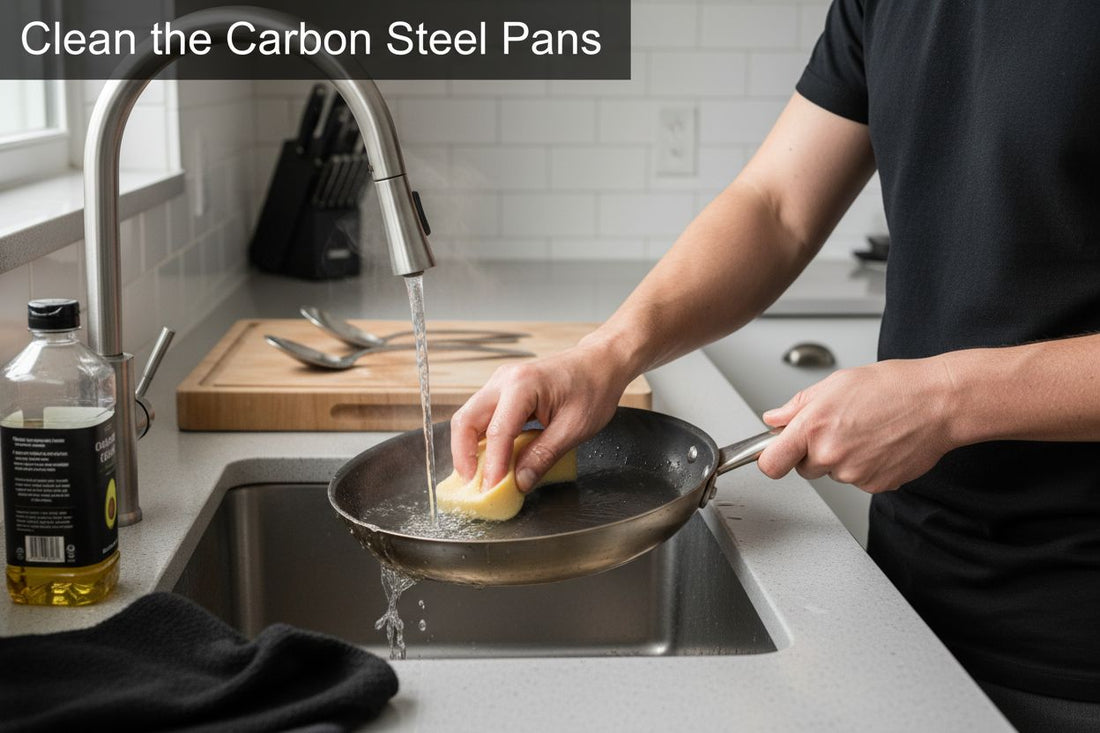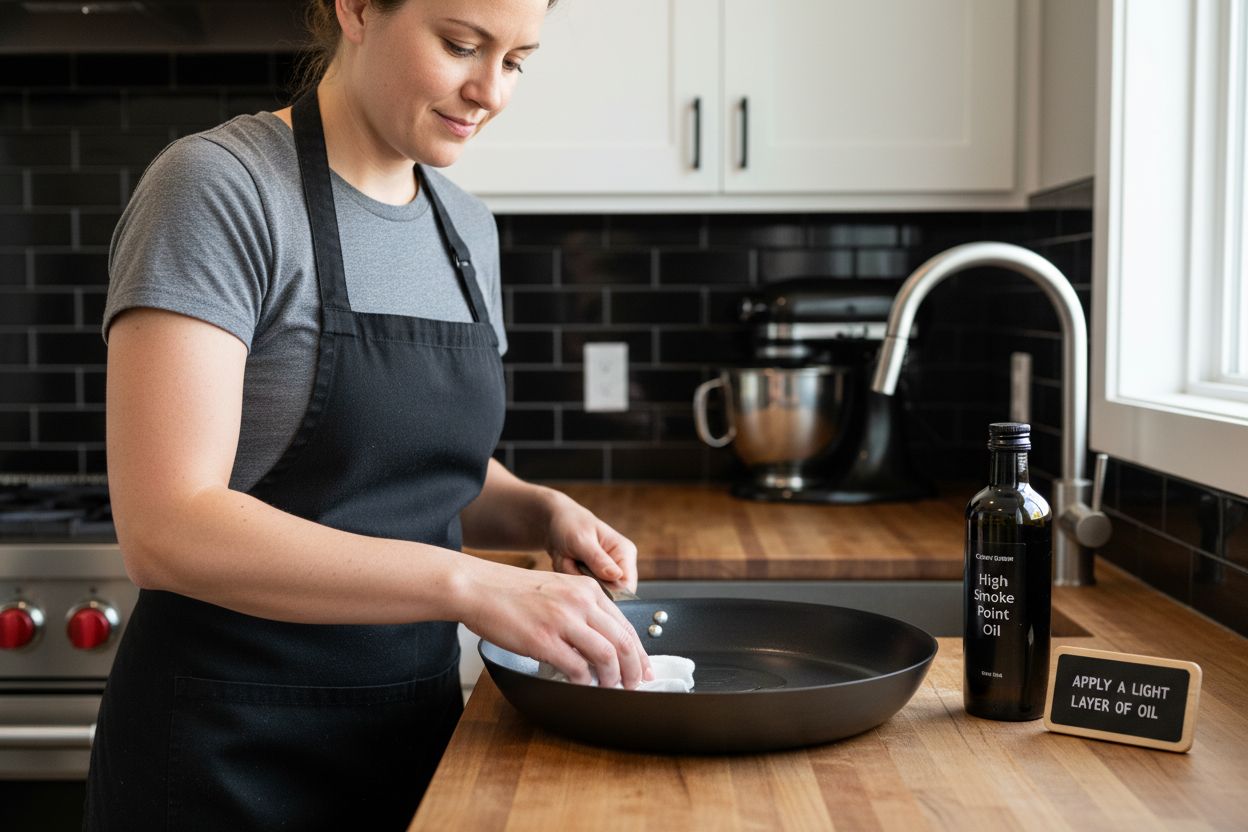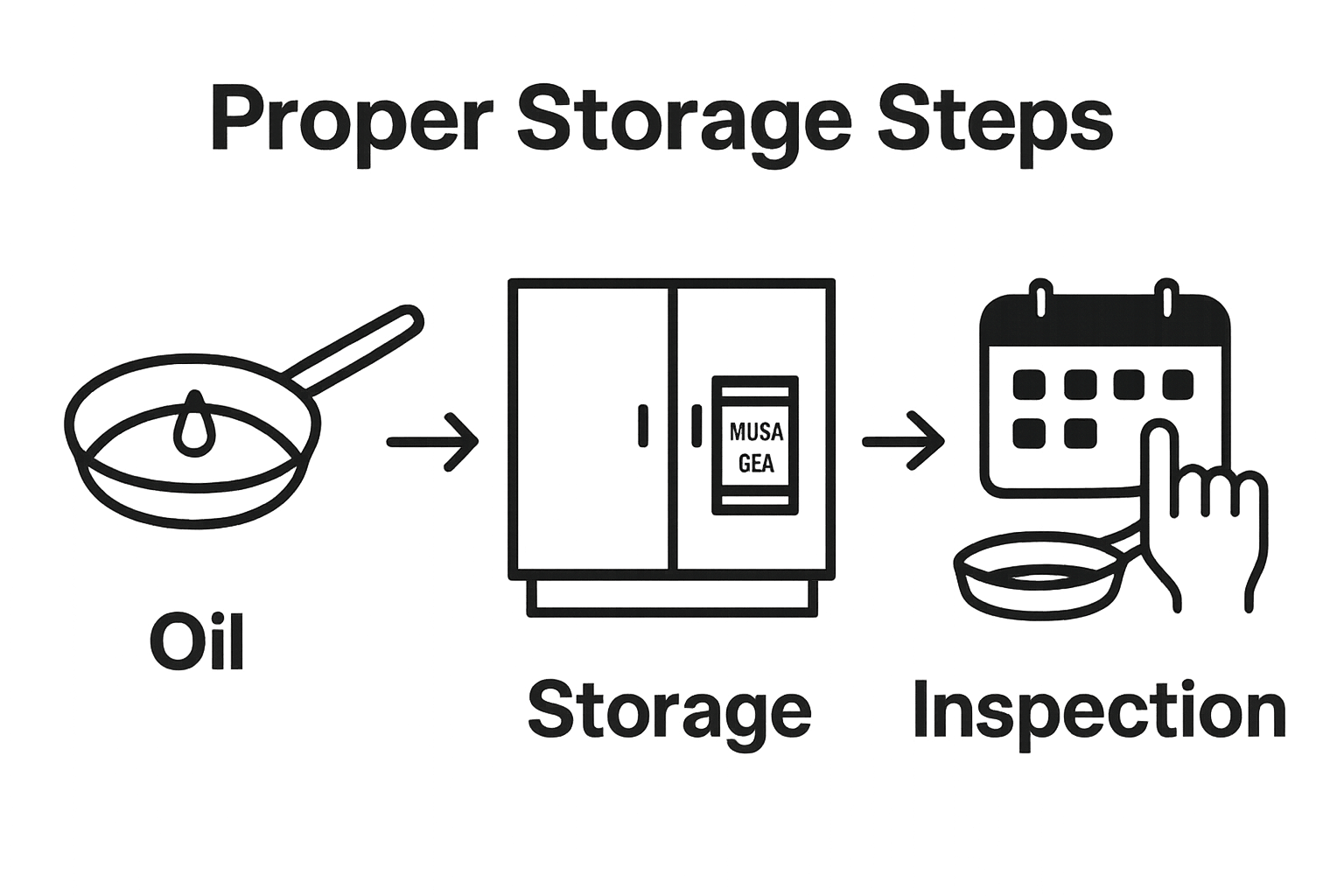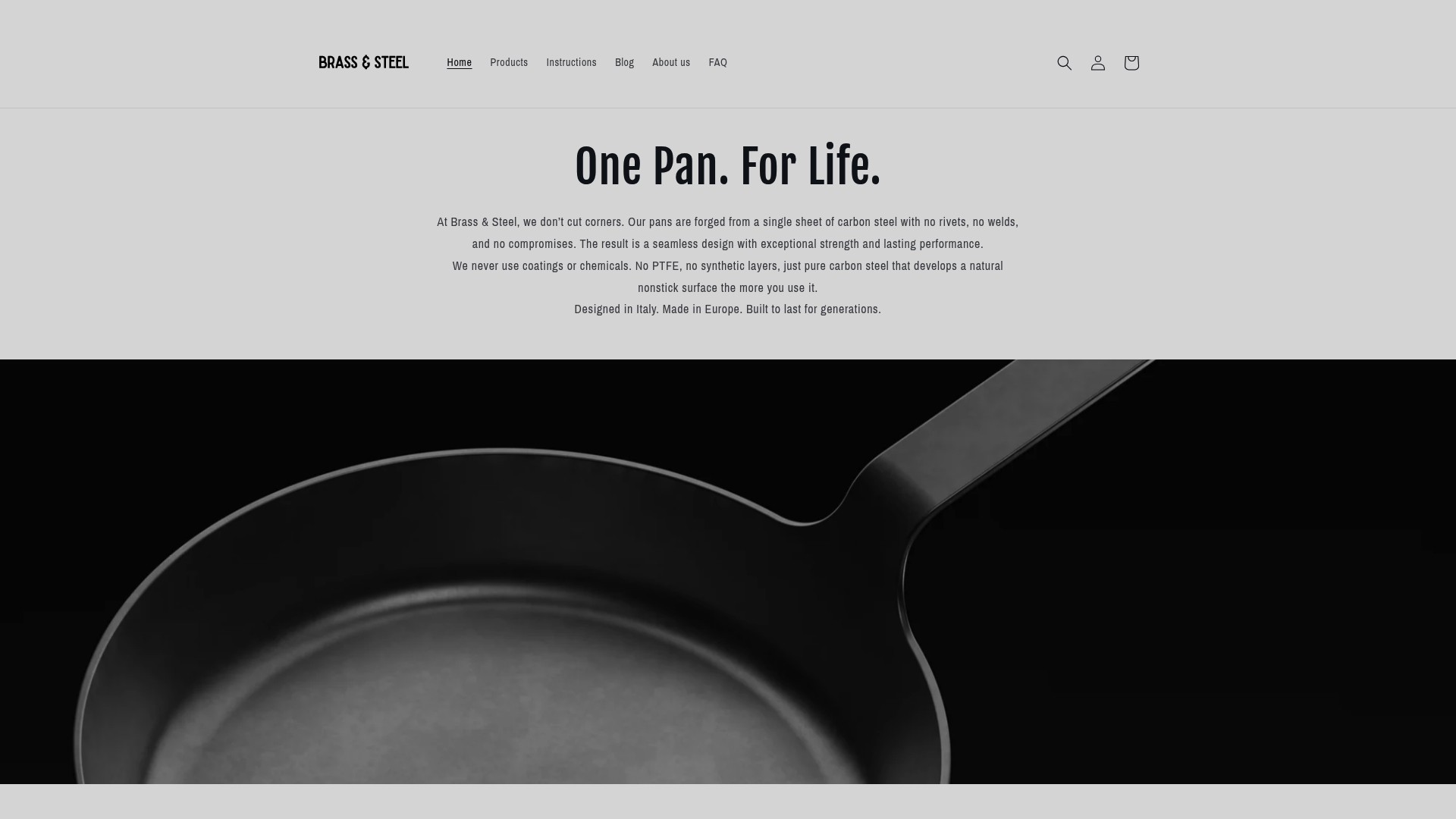
Master the Art of How to Store Carbon Steel Pans
Share
Storing a carbon steel pan properly does far more than keep your kitchen tidy. Skip just one step and you could destroy a beautiful finish in a matter of hours. Most cooks are shocked to learn that even a few minutes of trapped moisture can cause visible rust marks to appear overnight. The real secret is that protecting your pan is less about scrubbing and more about clever prevention—and these overlooked methods might just save your best pan from ruin.
Table of Contents
- Step 1: Clean The Carbon Steel Pans Thoroughly
- Step 2: Dry The Pans Completely To Prevent Rusting
- Step 3: Apply A Light Layer Of Oil For Protection
- Step 4: Store The Pans In A Cool, Dry Place
- Step 5: Check Periodically For Moisture And Oxidation
Quick Summary
| Key Point | Explanation |
|---|---|
| 1. Clean immediately after use | Remove food residue right after cooking to prevent rust and preserve seasoning. |
| 2. Dry thoroughly with heat | Use a warm stovetop for 3-5 minutes to eliminate moisture completely, preventing rust formation. |
| 3. Apply a thin oil layer | Use high smoke-point oil sparingly to create a protective barrier against moisture during storage. |
| 4. Store in a cool, dry place | Keep your pan in low humidity areas away from heat sources to maintain its condition. |
| 5. Inspect regularly for rust | Check every 4-6 weeks for signs of oxidation to catch issues early and perform necessary maintenance. |
Step 1: Clean the carbon Steel Pans Thoroughly
Cleaning your carbon steel pan thoroughly before storage is crucial for maintaining its pristine condition and preventing rust formation. The initial cleaning process sets the foundation for proper long-term preservation of your cookware.
Begin by removing any food residue immediately after cooking. Using warm water and a soft sponge or cloth, gently wash the pan without employing harsh detergents or abrasive scrubbers. Avoid soaking your carbon steel pan in water, as prolonged moisture exposure can trigger rapid rust development. If stubborn food particles remain, create a gentle cleaning paste using coarse salt and a small amount of hot water. Carefully scrub in circular motions to lift residue without damaging the pan’s seasoning.
After washing, dry the pan completely using a clean microfibre cloth or paper towel. Pay special attention to removing all moisture from the surface and edges. If time permits, place the pan on a warm stovetop for a few minutes to ensure absolute dryness. This step is critical because any remaining water droplets can initiate oxidation processes that compromise your pan’s integrity.
For stubborn residue and deep cleaning techniques, professional chefs recommend using a soft chain mail scrubber or wooden spatula to gently remove stuck-on food without stripping the pan’s protective seasoning. Always work methodically and avoid applying excessive force that might damage the pan’s surface.
Once cleaned and thoroughly dried, apply a whisper-thin layer of high smoke-point oil like grapeseed or avocado oil. Use a clean cloth to spread the oil evenly, creating a protective barrier against moisture and preventing rust formation during storage. This final oiling step is your pan’s first line of defence against environmental humidity and potential corrosion.
Successful cleaning is evident when your pan appears uniformly dry, slightly glossy from the light oil coating, and free from water droplets or food remnants. By following these meticulous cleaning steps, you ensure your carbon steel pan remains in optimal condition, ready for its next culinary adventure.
Below is a tools and materials table summarising the essential items mentioned in the guide for proper carbon steel pan maintenance:
| Tool/Material | Purpose | Special Recommendations |
|---|---|---|
| Warm water | Cleaning food residue | Use immediately after cooking |
| Soft sponge/cloth | Gentle washing | Avoid abrasive scrubbers |
| Coarse salt | Remove stubborn residue | Mix with hot water to form a gentle paste |
| Microfibre cloth | Thorough drying | Provides superior absorption, lint-free |
| Chain mail scrubber | Deep cleaning (for stubborn residue) | Use gently, do not damage seasoning |
| High smoke-point oil | Protective coating against moisture | Grapeseed, avocado, or sunflower oil |
| Paper towel | Even application of oil | Lint-free, for spreading a thin oil layer |
| Silica gel packets | Absorb moisture in storage area | Optional, enhances dry storage environment |
| White cotton gloves | Handling pan during inspections | Prevents introducing oils/contaminants |
Step 2: Dry the Pans Completely to Prevent Rusting
Drying your carbon steel pan thoroughly is a critical step in preventing rust and maintaining its exceptional cooking performance. Moisture is the primary enemy of carbon steel cookware, capable of transforming a pristine pan into a rusted surface within hours if not addressed properly.
Heat is your most reliable ally in the drying process. After washing, place the pan on a warm stovetop or in a low temperature oven at approximately 100 to 120 degrees Celsius. This method ensures complete moisture elimination while gently warming the metal, creating an environment hostile to rust formation. Professional chefs recommend spending about 3 to 5 minutes heating the pan, rotating it occasionally to ensure even drying across its entire surface.
If stovetop or oven methods are unavailable, use high quality lint-free microfibre cloths to manually dry the pan. Avoid regular kitchen towels, which can leave behind fibres and potentially introduce moisture. Microfibre cloths provide superior absorption and leave no residue. Focus on thoroughly wiping every surface area, paying special attention to corners, handle joints, and any textural irregularities where water might collect.
Preventing rust requires meticulous attention to moisture management. Some cooks use compressed air or a clean hair dryer on low heat setting to remove water from hard-to-reach areas, ensuring complete dryness. The goal is to eliminate all visible and invisible moisture traces that could trigger oxidation.
Verify your drying process by examining the pan under good lighting. A properly dried carbon steel pan will have a uniform, slightly metallic sheen without any water droplets or damp patches. The surface should feel completely dry to the touch, with no cool or damp sensations when you run your hand across it.
Remember that thorough drying is more than just a maintenance step it is a fundamental practice in preserving your carbon steel pan’s longevity and cooking performance. Each careful drying session contributes to building a resilient, naturally nonstick surface that will serve you through countless culinary adventures.
Step 3: Apply a Light Layer of Oil for Protection
Applying a protective oil layer is the final and crucial step in preparing your carbon steel pan for storage. This thin coating acts as a shield against moisture, preventing rust and maintaining the pan’s seasoned surface during periods of non use.
Select high smoke point oils for this process. Grapeseed, avocado, and sunflower oils are exceptional choices due to their stable molecular structures and ability to create a thin, protective barrier. Avoid olive oil or animal fats, which can become rancid and compromise your pan’s condition. The key is using an extremely minimal amount of oil just enough to create a barely visible, uniform layer across the entire pan surface.
Using a clean, lint free cloth or paper towel, apply the oil in a circular motion. Start from the centre of the pan and work outwards, ensuring complete coverage including the exterior, handle, and bottom. Apply so sparingly that the pan appears almost dry after application. Excess oil will become sticky and attract dust, potentially creating a breeding ground for bacteria or interfering with future seasoning.
Our comprehensive guide on carbon steel maintenance recommends warming the pan slightly before oil application. A gentle warmth helps the oil spread more evenly and allows it to bond more effectively with the metal surface. Use low heat on a stovetop or place the pan in an oven set to approximately 50 degrees Celsius for a few minutes before oiling.
Professional chefs suggest rotating the pan during the oiling process to ensure every angle receives equal protection. Pay special attention to areas prone to moisture accumulation like handle joints and pan edges. The goal is creating an invisible, uniform protective barrier that will guard against oxidation during storage.
To verify successful oil application, examine the pan under good lighting. A correctly oiled carbon steel pan will have a subtle, uniform sheen without visible oil droplets or uneven patches. When you touch the surface, it should feel smooth and slightly slick, but not greasy.
 This thin protective layer will keep your pan in pristine condition, ready for your next culinary adventure.
This thin protective layer will keep your pan in pristine condition, ready for your next culinary adventure.
Step 4: Store the Pans in a Cool, Dry Place
Choosing the right storage location for your carbon steel pan is a critical final step in maintaining its pristine condition. The environment you select can significantly impact the pan’s longevity, preventing rust and preserving its seasoned surface.
Temperature and humidity are your primary considerations. Seek out storage areas with consistent, moderate temperatures and low humidity. Kitchen cabinets away from the stove or dishwasher are ideal, as these appliances generate heat and moisture that can compromise your pan’s protective coating. Avoid storing your carbon steel cookware near windows, refrigerators, or areas with significant temperature fluctuations that might introduce condensation.
If horizontal storage is possible, place the pan flat on a shelf with nothing stacked directly on top of it. This prevents potential scratching or pressure that might damage the seasoned surface. When vertical storage is necessary, use pan organisers or hooks that support the pan without putting stress on its edges. Ensure the pan hangs freely without touching other cookware, which could scrape away the protective oil layer.
Preventing rust and maintaining your carbon steel pan requires strategic placement. Consider using silica gel packets in your storage area to absorb excess moisture.
 These small desiccant packets create a dry microenvironment that further protects your cookware from potential oxidation.
These small desiccant packets create a dry microenvironment that further protects your cookware from potential oxidation.
Professional chefs recommend periodic inspection even during storage. Every few weeks, remove the pan, check for any signs of moisture or potential rust, and reapply a light oil layer if needed. This proactive approach ensures your carbon steel pan remains in optimal condition, ready for immediate culinary use.
To verify proper storage, conduct a simple inspection when retrieving the pan. The surface should remain uniformly coloured, free from rust spots or moisture rings. When you touch the pan, it should feel smooth with its protective oil layer intact. A well stored carbon steel pan maintains its seasoned patina and stands prepared for your next cooking adventure, reflecting the care and attention you’ve invested in its preservation.
Step 5: Check Periodically for Moisture and Oxidation
Regular inspection is the final sentinel in protecting your carbon steel pan from potential damage. Periodic checks serve as a crucial preventative measure, allowing you to identify and address any early signs of moisture accumulation or rust formation before they become significant problems.
Develop a consistent inspection routine by examining your pan every four to six weeks. Use natural light or bright overhead lighting to reveal subtle changes in the pan’s surface. Look carefully for telltale rust indicators: small reddish brown spots, discolouration, or areas with a dull, textured appearance different from the pan’s seasoned finish. These early warning signs suggest moisture has compromised your pan’s protective layer.
When conducting your inspection, use clean hands or white cotton gloves to prevent introducing additional oils or contaminants. Run your fingertips gently across the pan’s surface, feeling for any rough patches or unusual textures that might indicate emerging rust. Visual and tactile examinations provide complementary insights into your cookware’s condition.
Maintaining your carbon steel cookware requires vigilant monitoring and immediate corrective action. Should you discover minor rust spots, do not panic. Small areas can be remedied by gentle scrubbing with fine steel wool, followed by thorough cleaning, complete drying, and re-seasoning. Larger rust areas might require more intensive restoration or potentially professional treatment.
Professional chefs recommend creating a simple inspection log. Note the date of each check, any observations, and actions taken. This systematic approach transforms maintenance from a reactive to a proactive process. Consider keeping a small microfibre cloth and high smoke point oil nearby during inspections, enabling immediate touch up if needed.
Successful periodic checks result in a pan that maintains its rich, dark seasoned surface with a smooth, uniform appearance. When you run your hand across the pan, it should feel consistently sleek without any rough or powdery sections. The pan’s colour should remain deep and consistent, reflecting the robust protection you’ve carefully cultivated through meticulous maintenance and storage practices.
The following troubleshooting table details common issues, their likely causes, and practical solutions as referenced throughout the article:
| Problem | Likely Cause | Recommended Solution |
|---|---|---|
| Rust spots appearing | Trapped or residual moisture | Scrub gently with fine steel wool, dry thoroughly, re-season |
| Sticky or tacky pan | Excess oil applied before storage | Wipe off excess, heat pan lightly, re-apply a thinner oil layer |
| Loss of seasoning | Abrasive cleaning or improper drying | Re-season pan following standard protocol |
| Food sticking to pan | Insufficient seasoning or oil layer | Clean, dry, and re-season as needed |
| Discolouration patches | Localised moisture exposure or rust | Inspect, scrub gently, dry, oil, and monitor for changes |
Take the Next Step in Protecting Your Carbon Steel Pan
Now that you understand how rust, moisture, and improper storage can threaten your cherished cookware, why not upgrade to pans that are truly built to last? Our exclusive Carbon Steel Collection offers you single-piece forged pans that make storage and upkeep simple. Each Brass & Steel carbon steel pan is designed without rivets or welds, meaning fewer places for moisture to hide and less risk of rust over time. You will experience the peace of mind that comes from minimal maintenance and superior engineering.

If you are ready to safeguard your investment and enjoy effortless storage, explore our collection today for genuine heirloom quality. Choose the pan that matches your cooking ambitions and rely on our easy-care guides for lifetime performance. Discover the difference at Brass & Steel and give your kitchen the tools it deserves. Act now and make each dish a showcase of true craftsmanship.
Frequently Asked Questions
How do I clean my carbon steel pan before storing it?
To clean your carbon steel pan, remove any food residue immediately after cooking using warm water and a soft sponge. Avoid soaking the pan and use coarse salt with hot water for stubborn residues. Ensure the pan is completely dry before storing it.
What type of oil should I apply to my carbon steel pan before storage?
Use a high smoke point oil such as grapeseed, avocado, or sunflower oil to create a protective layer. Avoid olive oil or animal fats, as they can become rancid. Apply a very thin layer, just enough to create a barely visible coating on the pan’s surface.
How can I prevent rust on my carbon steel pan during storage?
To prevent rust, ensure the pan is entirely dry after washing, apply a light layer of protective oil, and store it in a cool, dry place. Avoid areas with high humidity or temperature fluctuations.
How often should I check my carbon steel pan for moisture or oxidation?
Inspect your carbon steel pan every four to six weeks for signs of moisture or rust. Look for discolouration, texture changes, or small rust spots, and take immediate action if you detect any issues.
Recommended
- Cooking with Carbon Steel Step by Step: Mastering Techniques – Brass & Steel
- Master Using Carbon Steel on Induction for Perfect Cooking – Brass & Steel
- What is Carbon Steel Maintenance? Understanding its Importance – Brass & Steel
- How to Season a Carbon Steel Pan (Step-by-Step Guide) – Brass & Steel